For such a small state, New Jersey has a lot going for it. After all, the first organized baseball happened here in 1846. In addition, it’s home to Liberty State Park, from which a ferry service runs to Ellis Island, and Thomas Edison built his well-known laboratory in Menlo Park.
Even though all of New Jersey’s counties are considered urban, there are still a few wild areas where nature thrives. We’ve tracked down the largest animals you can find in the Clam State.
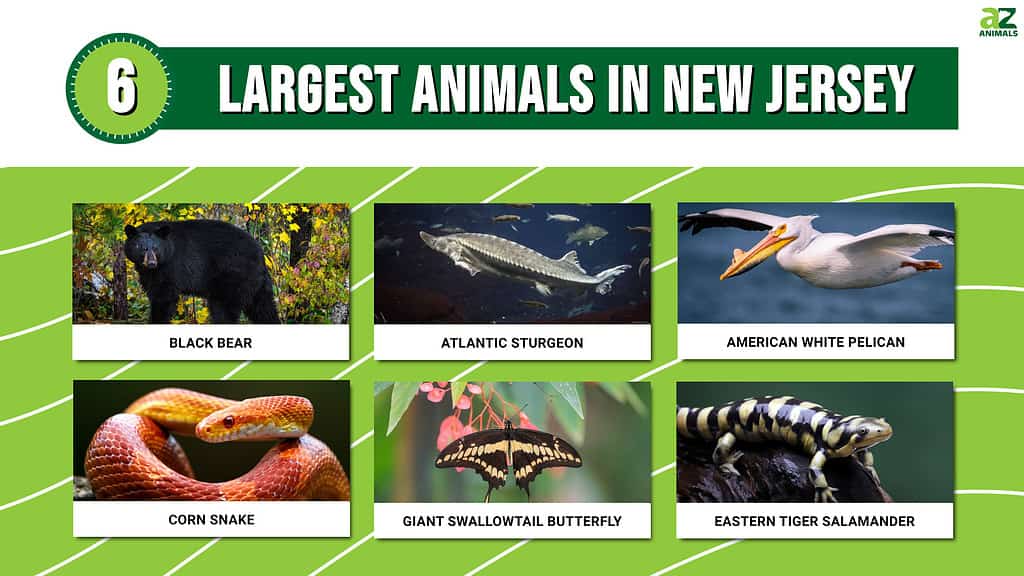
Now that you’ve had a quick look at the animals in question, let’s read on for more detail about their behaviors, habitats, and more!
New Jersey’s Largest Mammal: Black Bear (Ursus americanus)
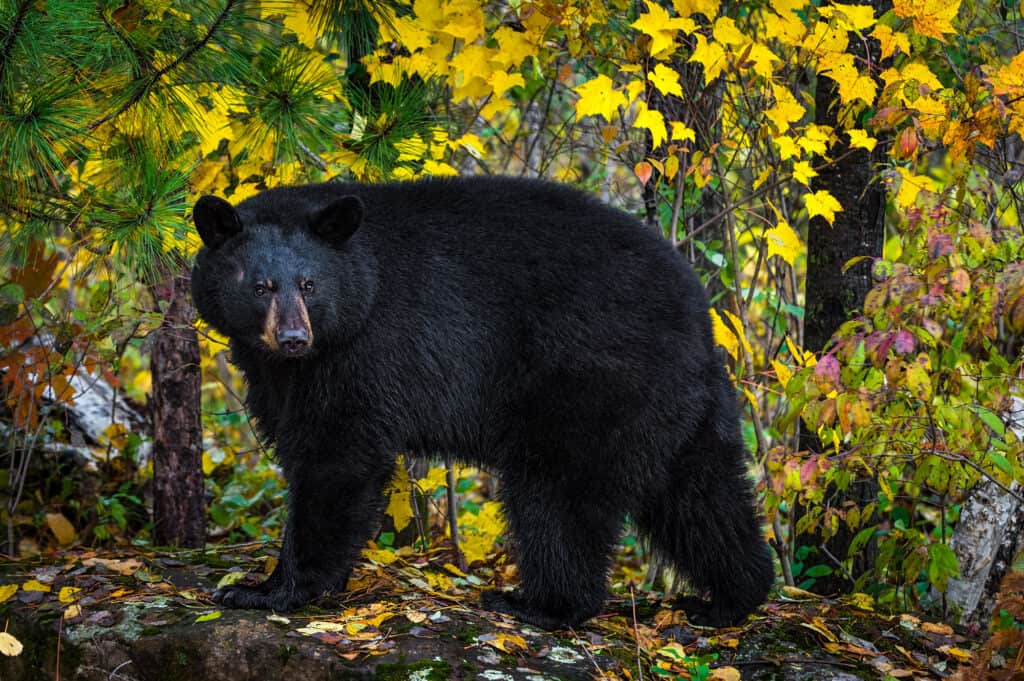
Contrary to its name, black bears aren’t all black – they range from shades of brown to pitch black.
©Holly Kuchera/Shutterstock.com
According to the New Jersey Department of Fish & Wildlife, New Jersey is home to approximately 450 mammalian species. Most are small, like the pygmy shrew, but a few, like coyotes and bobcats, are bigger animals. However, the largest mammal to call the state “home” is the American black bear.
Contrary to its name, black bears aren’t all black – they range from shades of brown to pitch black. While most black bears in New Jersey are black, there’s at least one report of a cinnamon-brown black bear; in addition, about 15% of the black bears in the state have a white blaze on their chests.
Black bears often follow their sense of smell – which can be described as” gifted” – into residential neighborhoods, behind restaurants, into campgrounds, and into the vehicles of unsuspecting people after food. A bear has a nasal mucous membrane area 100 times larger than a human. As a result, they can detect a scent more than two miles away from the source, making their nose something a bloodhound would envy.
This species also has good hearing and excellent color vision, although they are nearsighted. Seeing colors helps them locate ripe berries and fruits while they forage – a helpful skill; after all, who wants to eat unripe fruit? Their diet is primarily vegetation, but black bears also eat fish, insects, bird eggs, small mammals, and carrion.
You’ll see black bears in mixed hardwood forests, forested wetlands, and dense swamps. They prefer habitats with thick cover but are highly adaptable and can even live near human developments. In New Jersey, black bears’ best habit is in Sussex, Passaic, Morris, and Warren counties, and their population is expanding.
Black bears are New Jersey’s largest mammal and stand about three feet tall when on all fours, but they can reach five to seven feet tall when they stand up. Their weight varies dramatically during the year, ranging from 150 to 600 pounds.
Largest Fish in New Jersey: Atlantic Sturgeon (Acipenser oxyrinchus)
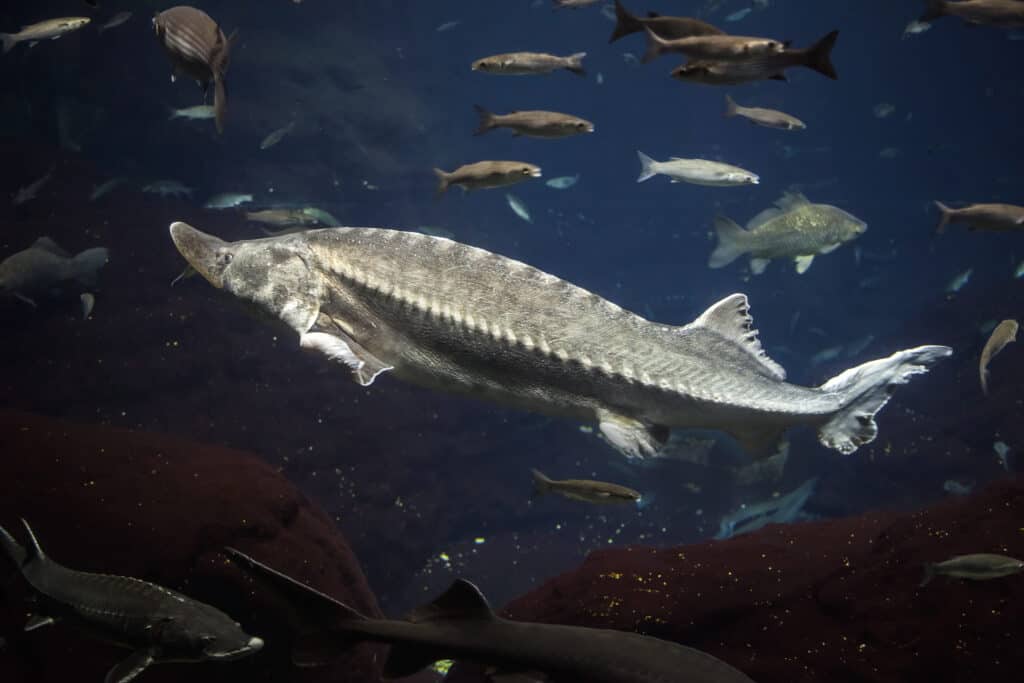
Like all sturgeon, the Atlantic sturgeon is a primitive fish with rows of bony plates, called scutes, down the length of its body.
©Evannovostro/Shutterstock.com
The PondInformer.com says there are 27 extant sturgeon species, but 23 of those 27 are endangered or threatened. They’re extremely tough fish, well-adapted to cold water, and some live over 100 years. So we’re not surprised to find a sturgeon on our list of largest animals in New Jersey.
Members of this ancient group of fishes inhabit fresh and salt water worldwide. The Atlantic sturgeon ranges from Canada to Florida in coastal waters and rivers. This species migrates to the ocean as sub-adults, then return to its birthplace as adults to spawn.
Like all sturgeon, the Atlantic sturgeon is a primitive fish with rows of bony plates, called scutes, down the length of its body. Its tail fin looks like a shark, with the top lobe larger than the bottom, and its dorsal fin is set just in front of the tail fin. This fish grows slowly and doesn’t reach maturity for several years; when it reaches maturity, it only breeds every few years.
This species used to be abundant, but overfishing and habitat loss have taken their toll. This species was sought out for its eggs as high-quality caviar. Between 1887 and 1905, the annual catch fell from 7 million pounds to 20,000 pounds, and 1989 only saw 400 pounds recorded. The problem is that those numbers don’t accurately reflect which type of sturgeon were harvested – they don’t differentiate between Atlantic sturgeon and shortnose sturgeon – making determining historical trends of the two species difficult.
As New Jersey’s largest fish, Atlantic sturgeon can grow up to 16 feet long and weigh 800 pounds. The species is protected, and its biggest threats are accidental bycatch, dams blocking spawning area access, and poor water quality.
Largest Bird in New Jersey: American White Pelican (Pelecanus erythrorhynchos)
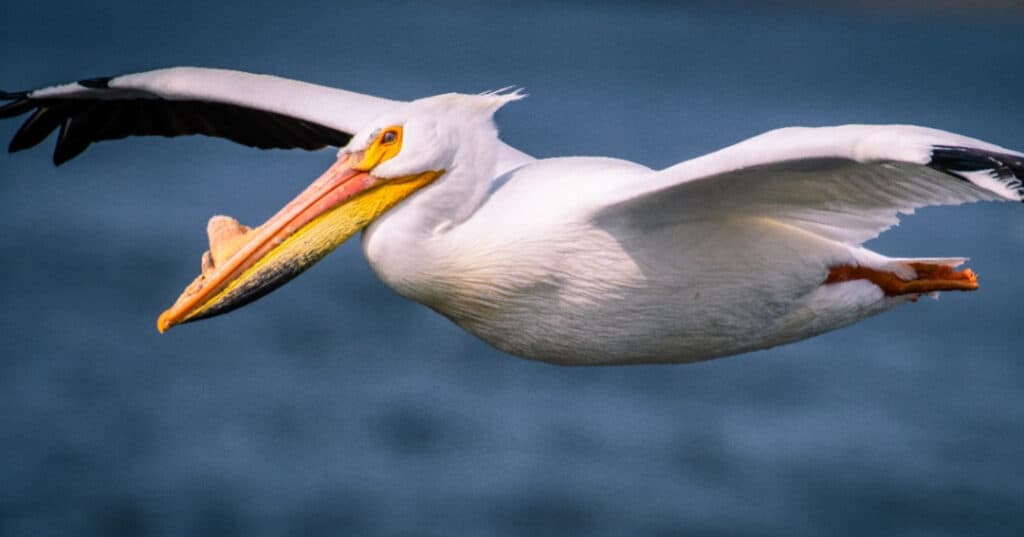
American white pelicans have a wingspan of 9 feet.
©Jerek Vaughn/Shutterstock.com
American white pelicans are distinctive birds that stand out for more than their enormous wingspan. These flying pescatarians spend spring and summer at inland estuaries, where their breeding grounds are located, then migrate south to warmer areas when winter arrives.
When they fly, American white pelicans move in flocks with birds on rotation, taking turns in the front. Many bird species do this; it’s an effort to conserve energy because the bird in front uses more energy in flight than those trailing behind.
These birds have all white feathers except for their black flight feathers. American white pelicans have orange beaks, which grow a large horn during mating season. Scientists believe the horn protects the more fragile beak during fights for mating rights. After all the eggs are laid, the horn falls off, and the pelicans return to normal.
Unlike brown pelicans, American white pelicans don’t dive bomb the fish. Instead, these birds swim along and nonchalantly scoop up their meals. Groups of pelicans work together, herding fish into shallow waters so they can quickly grab them.
North America is home to several enormous birds – the California condor and bald eagle come to mind – but in New Jersey, the American white pelican’s 8-10 foot wingspan makes it the largest bird in the state.
Largest Snake in New Jersey: Corn Snake (Pantherophis guttatis) and Black Rat Snake (Pantherophis alleghaniensis)
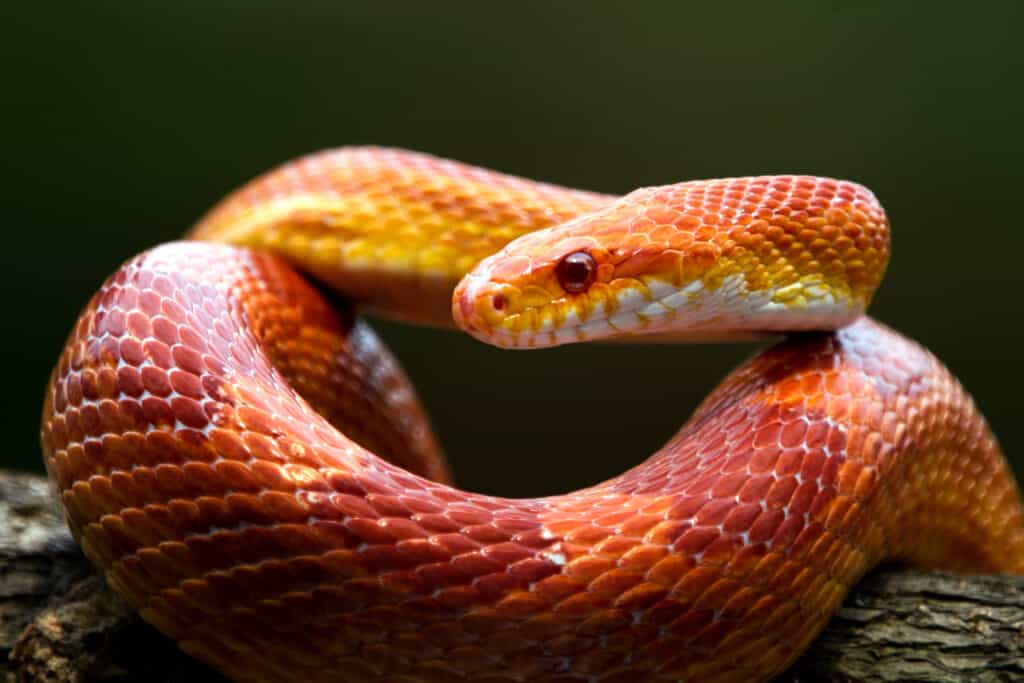
The corn snake is a nonvenomous colubrid that’s also sometimes called the red rat snake.
©Kurit afshen/Shutterstock.com
Being in a colder region, New Jersey doesn’t have many snake species. It has only two venomous snakes, the northern copperhead and timber rattlesnakes, which don’t often exceed four feet in length. However, there are nearly two dozen snake species in the state, and two are rat snakes.
The corn snake is a nonvenomous colubrid that’s also sometimes called the red rat snake. It earned the corn snake moniker either because it hung out near corn storage chasing the mice that ate the corn, or because it has a checkered pattern on its belly that looks like maize. It’s anyone’s guess at this point, but the fact remains that the corn snake’s bright reds and oranges make it a popular pet snake.
In contrast, the black rat snake begins life with the typical rat snake pattern of dark blotches over a lighter base but darkens to black with a light-colored belly and white chin within a couple of years. Some individuals retain the juvenile pattern, but in most, it’s all but gone.
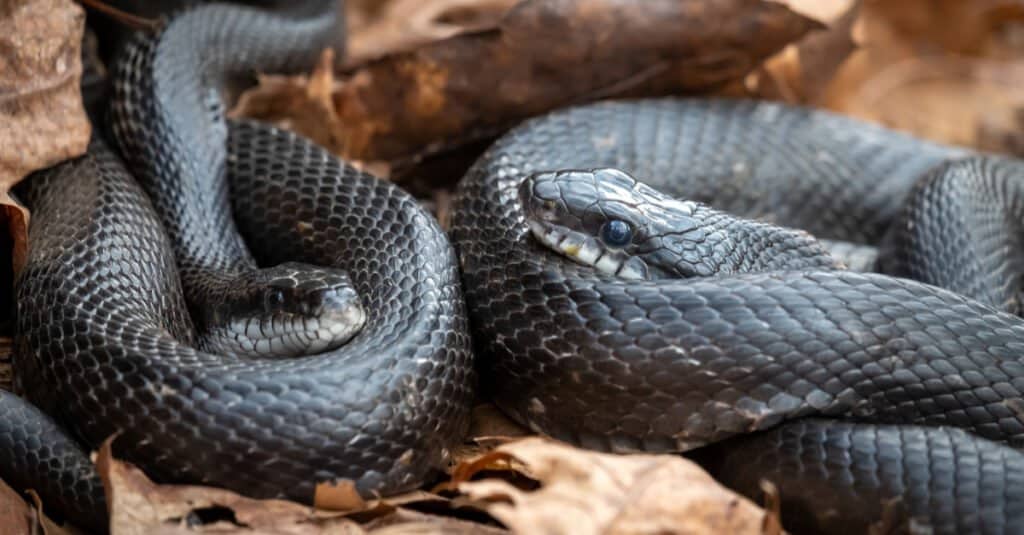
Rat snakes climb trees to eat eggs and
baby birds
from unguarded nests and smaller lizards and frogs.
©samray/Shutterstock.com
All rat snakes love eating rodents. However, they are opportunistic and excellent climbers. People often find these snakes in odd places, like climbing up the grout lines in a brick wall. Rat snakes climb trees to eat eggs and baby birds from unguarded nests and smaller lizards and frogs.
The largest snake in this state is a tie between two types of rat snakes. The black and red rat snakes can reach six feet in length, making them both the largest snakes in New Jersey.
New Jersey’s Largest Insect: Giant Swallowtail Butterfly (Papilio cresphontes)
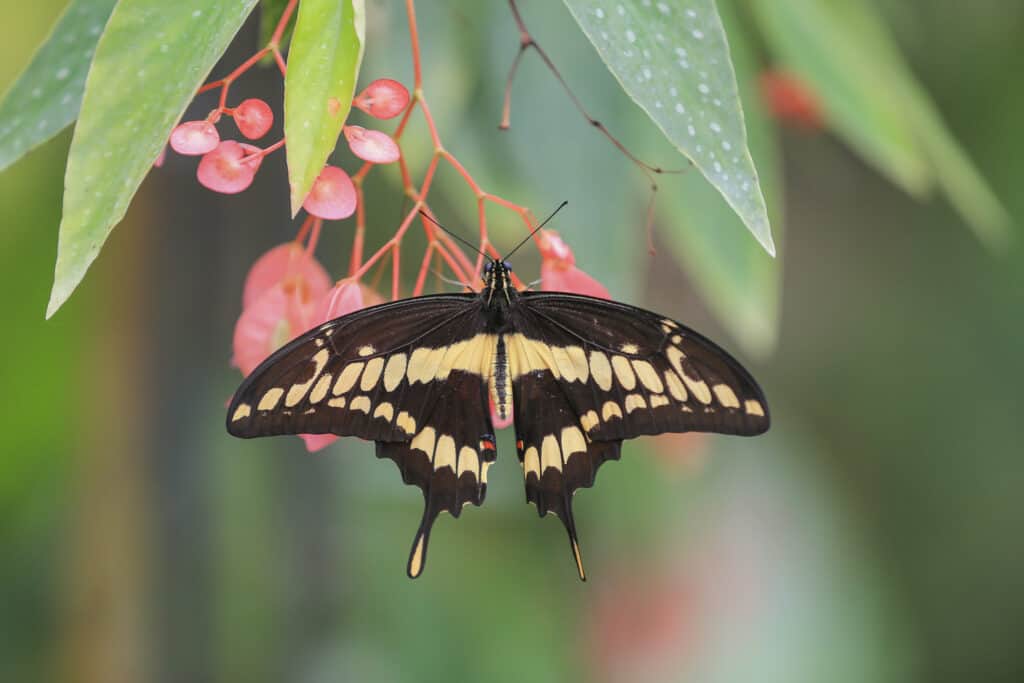
Giant swallowtail
butterflies
are among the biggest of all.
©iStock.com/rybalov77
Butterflies are one of the beautiful joys that summer brings. They feed on flower nectar, and most species have about a two-week lifespan. Their caterpillars can be damaging, but the butterflies are so incredible that we tolerate the destruction. In some cases, we even buy plants to feed the caterpillars.
Giant swallowtail butterflies are among the biggest of all. They’re unmistakable, with vivid yellow stripes over dark brown wings and long tails that extend off the lower pair of wings. They also have a red spot at the bottom of their wings, and females typically have brighter colors and longer wingspan than males.
Caterpillars of this species look like bird feces. It’s a pretty effective way to disguise oneself, as not many predators eat bird droppings. Females lay their eggs directly on host plants, including citrus, prickly ash, and rue. Once the eggs hatch, they go through several stages until they form a chrysalis.
While there may be walking stick bugs that are longer; however, they don’t live in New Jersey. The giant swallowtail butterfly has a nearly 6-inch wingspan and is New Jersey’s largest insect.
New Jersey’s Largest Amphibian: Eastern Tiger Salamander (Ambystoma tigrinum)
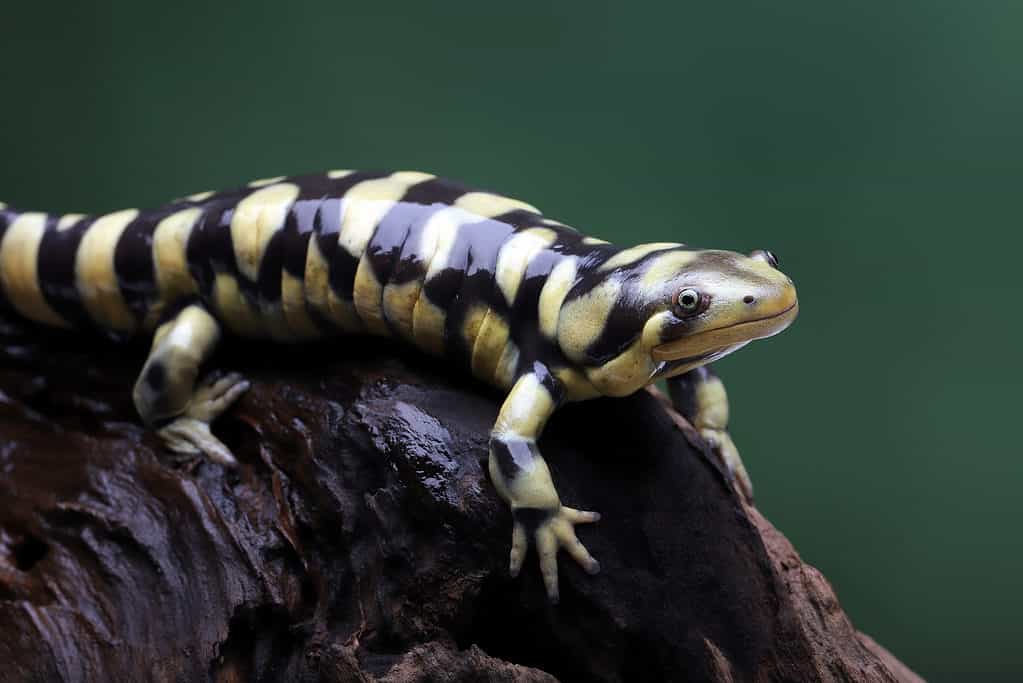
The eastern
tiger salamander
lives in habitats that include dense woodlands and open grassy fields.
©Lauren Suryanata/Shutterstock.com
Salamanders are odd, even among amphibians. They start as larval tadpole-type creatures and live underwater until they mature. Unlike frogs and toads, salamanders keep their tails, and some even keep their gills when they mature.
The eastern tiger salamander lives in habitats that include dense woodlands and open grassy fields. They can survive as long as there is loose soil for burrowing and digging dens. Unfortunately, these amphibians spend most of their lives underground, which makes them difficult to find. Once eastern tiger salamanders mature and leave the water, they only return to the water to breed.
When you spot one, eastern tiger salamanders have a dark brown or black base color with brownish-yellow to greenish-yellow spots. They have short snouts, stout necks, and long tails.
This species is prone to cannibalism if resources are scarce, but they prefer eating snails, slugs, small insects, frogs, and worms. They’re opportunistic and will feed on smaller salamander species, lizards, snake lets, and baby mice.
Unlike frogs and toads, salamanders tend to be the longest of the amphibians because they never lose their tails. Given that, it’s no surprise that the largest amphibian in New Jersey is the eastern tiger salamander.
Summary of the 6 Largest Animals in New Jersey
| Name of Animal | Kind of Animal | Habitat |
|---|---|---|
| Black Bear | Mammal | Hardwood forests, forested wetlands, and dense swamps |
| Atlantic Sturgeon | Fish | Coastal waters and rivers. |
| American White Pelican | Bird | Inland estuaries in spring/summer; go south for the winter. |
| Corn Snake/Black Rat Snake | Reptile | Woodlands, rocky hillsides, and around farm buildings. |
| Giant Swallowtail Butterfly | Insect | Lay their eggs directly on host plants, including citrus, prickly ash, and rue; as adults, live in open areas near flowers. |
| Eastern Tiger Salamander | Amphibian | Dense woodlands and open grassy fields. |
The photo featured at the top of this post is © Lauren Suryanata/Shutterstock.com
Sources
- Mammals of New Jersey, New Jersey Division of Fish & Wildlife, Available here: https://www.nj.gov/dep/fgw/chkmamls.htm
- Black Bear Biology & Behavior, Available here: https://dep.nj.gov/njfw/bears/black-bear-biology-and-behavior/
- Atlantic Sturgeon, NOAA Fisheries, Available here: https://www.fisheries.noaa.gov/species/atlantic-sturgeon
- Giant Swallowtail Butterfly, Field Guide to Common Texas Insects, Texas A&M Agrilife Extension, Available here: https://texasinsects.tamu.edu/giant-swallowtail-butterfly/
Thank you for reading! Have some feedback for us? Contact the AZ Animals editorial team.






